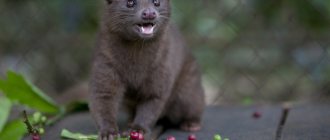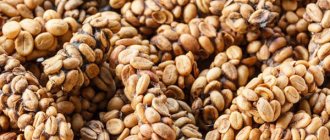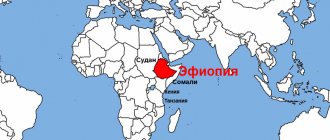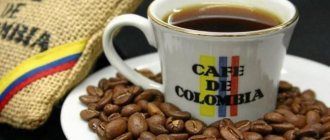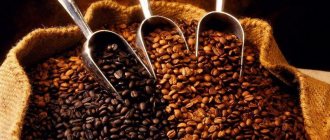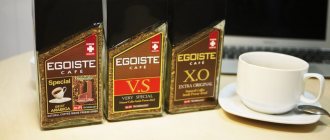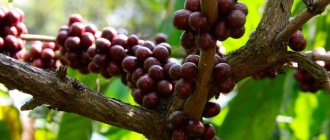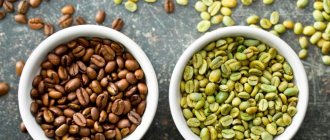The most expensive coffee in the world: Unsplash The most expensive coffee costs hundreds of dollars per kilogram. It is grown in unique climatic conditions, and not only people, but also animals are involved in the production process. The top ten most expensive coffee varieties are opened by Black Ivory.
What types of coffee are the most expensive? Luxhabitat magazine has compiled a list of the ten most expensive coffees in the world. It includes Black Ivory, Finca El Injerto, Hacienda La Esmeralda, Kopi Luwak, Saint Helena, Molokai, Blue Mountain, Fazenda Santa Ines, Los Planes and Mi Esperanza.
Black Ivory
Black Ivory: Wikipedia
What type of coffee is the most expensive in the world? This is Black Ivory. The name of the variety is translated as 'black ivory' for a reason. The digestive system of elephants produces the most expensive coffee in the world. It is made from Arabica beans in Thailand.
How much does the most expensive coffee in the world cost? The cost of Black Ivory is more than $1.1 thousand per kilogram of beans. The high price is due to the fact that most of the coffee cherry beans that are fed to elephants are chewed, severely damaged during digestion, or lost altogether. Those grains that were found intact have a unique aroma obtained from the stomach juice of the elephant.
Fifth place – I'll be back
Surely, you are wondering which coffee has received this mark. We present to you a unique option – Geisha (Geisha). The price per kilogram of this type of grain product varies from $290 to $330. Country of manufacture: Panama. It is interesting that in the 20s of the last century, experts practically put an end to this species. After all, in their opinion, it is absolutely not susceptible to many diseases, as a result of which these trees very often died. Thus, he was destined to sink into oblivion, but this did not happen. His Majesty chance intervened. The fact is that in 2003, one of the owners of coffee farms in Panama discovered these coffee trees on his property. And the most amazing thing is that it was thanks to them that I won the international competition. They say that one of the judges was so delighted that he wanted to purchase this species for his personal collection. It has citrus sourness, the taste of lime and lychee, and a delicate and long aftertaste. It is worth noting that the return of this variety is the most significant event in the coffee industry of the early 21st century.
Interestingly, a coffee product called GEISHA is produced in Colombia and, to be honest, is clearly inferior in taste to the original. And the very variety that we are talking about is produced by La Esmeralda and is produced under the same name. By the way, he has nothing to do with Japanese women with the same profession.
Hacienda La Esmeralda
Hacienda La Esmeralda ranks third in the world. One kilogram of this coffee will cost $800. It is grown in Panama on the slopes of Mount Baru in the shade of guava trees. The high price of the owner of excellent taste and rich aroma is determined by the unique knowledge and experience of the people who grow this coffee. During the production process, each grain is carefully inspected and weighed, which further increases labor and cost.
Robusta
Robusta is a very popular type of coffee (20% of world production), and in its popularity it is second only to Arabica. Robusta is a very resistant and productive variety. As tasters note, Robusta is a variety of lower quality compared to Arabica. Therefore, Robusta is mostly used as a budget option on the market. Robusta also contains a large amount of caffeine, but is endowed with a less intense aroma.
Kopi Luwak
The fourth most expensive coffee variety in the world is Kopi Luwak. It is produced in Vietnam and other countries in Southeast Asia. The main link in the production of this elite coffee is the digestive system of small civet animals. The fermentation process of the beans is somewhat similar to Black Ivory. The fruits of the coffee cherry are fed to the animals, collected and then thoroughly dried. The unique taste of coffee is due to enzymes secreted by the civet's digestive tract. In addition, the animals choose only the best grains. You can buy beans of this coffee for $350 per kilogram.
Arabica
Arabica is popular all over the world. The homeland of this variety is Ethiopia. A large number of other coffee varieties are produced through various mutations of Arabica or the cultivation of hybrids. There are also many options for preparing and roasting Arabian coffee beans.
Arabica
Often, many manufacturers use mixing Arabica and Robusta in various concentrations, which gives coffee all sorts of flavor effects and shades.
Saint Helena
The fifth most expensive type of coffee in the world is named after the island of St. Helena. This island is known not only as a place where elite coffee is grown, but also as the prison of the French Emperor Napoleon Bonaparte. Saint Helena coffee has a pleasant caramel flavor with hints of citrus. The cost of one kilogram of grains is about $175. The high cost is associated not only with a pleasant, special taste, but also with the difficulties of its transportation: St. Helena Island is located 1800 km from the coast of Africa.
Historical excursion
Africa is the birthplace of coffee. There is evidence that it was grown and consumed in Ethiopia as early as 850 BC. Initially, Ethiopians used exclusively fresh berries “for tone.”
A ripe coffee berry consists of a grain covered with a silver skin, a parchment shell covered with gluten, and pulp. Depending on the color of the pulp, the berry can be yellow or red.
The Arabs quickly adopted the traditions of Ethiopian culture, including the custom of drinking coffee.
The ancient recipe consisted of preparing a mixture from a simple composition:
- crushed fresh coffee beans;
- milk;
- animal fat.
The resulting mixture was used to make balls that travelers took on their long journey. This prehistoric energy drink invigorated and had a general strengthening effect. And only in the 12th century. semi-finished coffee products gave way to a drink made from raw beans.
How coffee “conquered” the whole world:
- XII century The process has evolved. Now the dried grains were roasted and then ground. Coffee powder was poured with boiling water. The Arabs were no strangers to gastronomic delights - they added herbs, spices and milk to coffee.
- XV century Thanks to merchants and travelers, the tradition of coffee drinking spread throughout the eastern countries, and then reached Europe. In 1555, the first public coffee house was opened in Constantinople.
- XVI century Coffee has gone “to the masses.” They began to drink it in different countries.
- Mid-17th century Coffee plantations were established in South India.
- End of the 17th century Coffee came to Russia: it was first mentioned in documents from the era of Peter I.
- Beginning of the 18th century The Dutch brought coffee seedlings to Indonesia - to the islands of Java and Sumatra, from there coffee migrated to South America. The Arab monopoly is over.
Today, coffee is cultivated in countries with tropical and subtropical climates. They form the “coffee belt” of the planet, which includes over 80 countries located in such regions of the globe as:
- Africa;
- Asia;
- Australia;
- South America;
- Central America.
For the last 150 years, Brazil has been the absolute leader in the world among coffee exporting countries. Every year, about 55 million bags of coffee beans are harvested in the country of “wild monkeys”.
The classic technology for preparing the drink, practiced in the first coffee shops, has not changed to this day.
Who drank "coffee" with special pleasure
There were legends about the French writer Balzac that he drank up to 50 cups of coffee a day. So he excited the muse in order to finish several novels on time. The quantity of the drink is clearly exaggerated - after all, we are not talking about the usual cups, but demitasses (French demi-tasse - “half a cup”), which held only 60 ml. However, it is a fact that the French prose writer was an ardent fan of coffee. They say that he even chewed grains when it was not possible to immediately brew a drink.
There are many great people among coffee lovers - Peter I (drank strong black coffee without sugar), Catherine II (she ordered 4 tablespoons of ground coffee to be brewed for one large cup of coffee), Napoleon (he adored coffee and considered it the greatest treasure of the world).
Johann Sebastian Bach dedicated his “Coffee Cantata” to his favorite drink, and coffee inspired Pushkin to create; he admitted in a letter to a friend: “I wake up at seven o’clock, drink coffee and lie in bed until three o’clock. I recently signed my name and have already written the abyss.” It is a known fact about Michel Lermontov that before the last duel he stopped at the famous Roshke coffee shop in the village of Inozemtsevo to cheer himself up with “coffee.” George Sand believed that only cigars and coffee could sustain her “pathetic inspiration.”
There is no limit to perfection
However, let's not lie: people did not immediately fall in love with coffee. At the assemblies of Peter I, nicknamed “forced fun,” they were not only forced to dance, but also served drinks unusual for Russian nobles - coffee, chocolate - which only increased the tension of the guests.
What frightened me most was the specific bitterness of the drink. But she also played a positive role. Recipes for preparing the drink began to be improved. To remove the bitterness, the following was added to it:
- cinnamon,
- cardamom;
- ginger;
- nutmeg;
- black pepper;
- cloves;
- cream or milk;
- sugar.
According to statistics, coffee lovers earn more than tea lovers. Scientific studies have shown that two to three cups a day do not cause any harm, but can significantly prolong a person’s life.
Main types of coffee:
- Arabica;
- robusta;
- liberica;
- Excel.
In recent years, coffee shops have become concept establishments. This trend is observed not only in megacities, but also in small towns and small resort towns. Russia is no exception to the rule. In our country, coffee shops are a fashionable meeting place. Therefore, their number is constantly growing.
Today, establishments offer popular drinks:
- espresso;
- cappuccino;
- look;
- latte;
- ristretto;
- mocha, mocaccino;
- Americano;
- Turkish coffee.
Morning espresso works better than any alarm clock
For their preparation, various varieties of Arabica are most often used, which have a soft and delicate taste. Robusta has a strong, slightly bitter taste. Liberica, due to its pronounced bitterness, is added to the coffee mixture only in small doses. It gives the drink a unique flavor bouquet. Excelsa is the rarest and most expensive coffee. Thanks to its deep taste and delicious aroma, it has captivated gourmets around the world. Coffee lovers are willing to pay impressive sums of money at auctions for exotic coffee.
Mi Esperanza
Mi Esperanza closes the top ten most expensive coffee beans in the world. This coffee costs $77 dollars per kilogram and is very popular among real coffee gourmets. Its main feature is a richer bitter aftertaste than other varieties. Mi Esperanza has a vibrant nutty and multi-spice flavor that further appeals to coffee lovers.
To experience the unique taste and aroma, gourmets are ready to shell out for the most expensive varieties of coffee. Each of the presented varieties is produced using a unique technology and has a unique taste and breathtaking aroma. Don't believe me? Try it and see for yourself.
Original article: https://www.nur.kz/leisure/interesting-facts/1148858-a-vy-gotovy-platit-50-za-chashku-kofe-10-samyh-dorogih-sortov-foto/
Guatemala El Injerto Coffee
A delicate creamy structure, subtle acidity, notes of jasmine and exotic fruits, and a long aftertaste with a hint of cocoa characterize the product from Guatemala. The coffee plantations here are located at an altitude of 1650 m above sea level, occupied mainly by Pacamara, Maragogipe, and Bourbon varieties.
For 1 kg of El Ingerto coffee you will have to pay about $1,100.
Why does coffee sour?
Sometimes a prepared drink has a sour taste, and an unprepared person may think that it is spoiled, which is completely wrong. He probably just hasn’t come across the concept of sourness in coffee yet.
This is a mandatory property of all Arabica beans: the higher the trees grow, the more sour the drink from the beans will be. Robusta does not have this quality.
In addition, the taste of the drink depends on the degree of roasting. If the beans are lightly roasted, then the coffee will definitely be sour, and if the beans have acquired a black tint, then in most cases it will not be sour, but will rather be bitter.
Hacienda Santa Ines
This is perhaps the best coffee produced in Brazil. Refreshing notes of citrus and a taste of chocolate prevent this coffee from being confused with other varieties.
450 grams of Fazenda Santa Ines, costs $50.
Coffee beans of this variety have become especially popular and widespread in Brazil and Canada. The main distinguishing factor is the manual collection of grains.
Los Plains
Los Plains are grown in El Salvador. It has a sweet floral aroma, and bright notes of cocoa are felt in the taste. Also, it is worth noting that the taste of this coffee is very rich and opens with each subsequent sip of the aromatic drink.
Price 450 gr. of Los Plains coffee beans is $40.
Los Plains coffee has received many international awards and its taste is highly valued by gourmets.
Yellow Bourbon
"Yellow Bourbon" is a rare variety of Brazilian Arabica, which is grown on highland plantations in the southern region of the country. The first mention of this variety was in 1859.
Yellow Bourbon
“Yellow Bourbon” stands out for its sweetness combined with a slight bitterness. After a cup of this coffee, a woody-tobacco shade remains, associated with sunny Brazil.
Coffee plantation tour
After the cages with the animals, we watched how the grains, initially not yet separated from the excrement, were dried on special trays placed in the sun.
then the selected and washed grains are dried,
after which, completely prepared and dried grains await their turn for the next process.
Next, we observed the next stage of transformation - roasting the coffee beans.
So on the plantations you can see the entire process of coffee transformation - from the berries that grow on the trees, to the usual roasted beans or even ground coffee packaged in packs for sale.
We even had a hand in the roasting process - the boy stirring the beans honored us and handed us his ladle.
Sumatra Mandheling
Sumatra Mandheling
The island of Sumatra is the primary source of a wonderful variety of coffee, which has a wonderful rich taste with a mixture of spices (smokiness, spices, caramel, etc.). Coffee has low acidity, but tasters note a heavy aftertaste of this variety. Mandheling is a coffee for everyone, so not everyone may like it.
